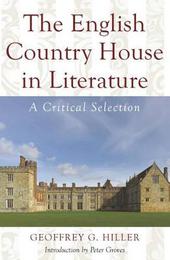
|
The English Country House in Literature: A Critical Selection
Hardback
Main Details
| Title |
The English Country House in Literature: A Critical Selection
|
| Authors and Contributors |
Introduction by Peter Groves
|
|
Edited by Geoffrey G. Hiller
|
| Series | Literary Studies |
|---|
| Physical Properties |
| Format:Hardback | | Pages:300 | | Dimensions(mm): Height 234,Width 156 |
|
| Category/Genre | Literature - history and criticism |
|---|
| ISBN/Barcode |
9781922235299
|
| Classifications | Dewey:808.803564 |
|---|
| Audience | |
|---|
|
Publishing Details |
| Publisher |
Monash University Publishing
|
| Imprint |
Monash University Publishing
|
| Publication Date |
1 January 2015 |
| Publication Country |
Australia
|
Description
This anthology brings together some of the finest writing in English on the subject of the English country house, a topic currently enjoying a renascence of academic and general interest. The houses represented are for the most part fictional, and the extracts illustrate the various ways in which such descriptions function as part of the system of meanings in a novel, play, or poem. People shape their houses and their houses shape them. Houses may be seen as architectural metaphors of their owners. The extracts of this anthology demonstrate that an author's descriptions of a country houses features make it a metonym of its owners or occupiers. In a vast number of instances houses are depicted (even before the owner is described) in such a way as to give insights into, or clues to, his or her social status, and ethical and moral tastes. The various glimpses that the extracts provide of the country house its architecture, its garden, the well-being of its servants and tenants, the hospitality (or lack of it) that its guests experience, the extent of the paternalism in the running of the estate all in some way reflect the character of the owners.The huge ostentatious villa of Popes Timon reflects the vulgar pretension of its owner, and the noble house and demesne of Beaumanoir is a home befitting the cultured and hospitable Lord Henry Sydney in Disraeli's Coningsby. Moreover, by implication the house itself may well become a representative example of others of its kind: so we are led to believe that Jane Austens Pemberley in Pride and Prejudice with its tasteful elegance is a type of many others such; and that (later) there are many houses throughout England like Waughs Brideshead whose glory has vanished after the second World War. The Introduction provides some historical and cultural context for the institution of the country house and traces some of the themes and topics that have persisted or been transformed during the long period (from the sixteenth century to the twentieth) of its representation in English literature. Each extract has a short introduction that provides its context, indicates salient details, and in doing so makes clear why it has been included. With the exception of Spenser, texts are in modern spelling and specific sources are listed separately at the end of the book.
Author Biography
Geoffrey G. Hiller was educated in Hobart, Tasmania, before completing his PhD at Cambridge University. He is an Adjunct of Monash University. Peter Groves (Rhythm and Meaning in Shakespeare) is a senior lecturer at the same university.
ReviewsHiller's anthology imbues a modem reader with the facility to study the ideologies, social functioning, and decline of these institutions, in order to consider why country houses have endured. The English country house continues to live large in the collective imagination, and Hiller's work offers an apt way for a reader to consider the boundaries between mythology, nostalgia, and history. Sarah Dempster, Honorary Research Fellow, University of Western Australia. Feb 2016
|